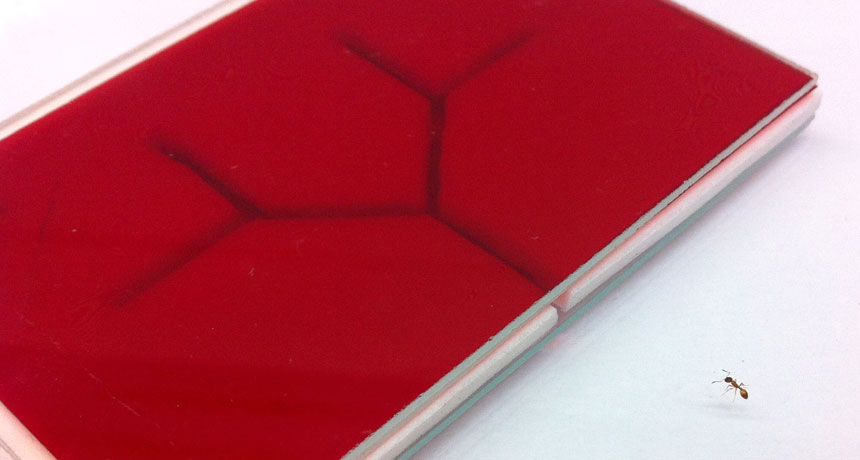
TURNING TEST This tiny rock ant probably has a tendency to turn left when exploring the forking corridors of red-roofed simulated nesting chamber, says a new lab test.
E.R. Hunt
Rock ants show a lefty bias when picking which way to turn in strange, dark places.
The tiny, crevice-dwelling Temnothorax albipennis ants don’t have hands, of course, but a tendency similar to handedness shows up in choosing the direction to turn when exploring, Edmund R. Hunt of the University of Bristol in England found in lab tests. The ants also have a tendency to follow a wall, but when willing to step away from it show a leftist bias, Hunt and his colleagues report December 24 in Biology Letters.
Hunt, who trained as a physicist, has turned to ant colonies to explore how simple rules for behaving can create complex outcomes. When rock ants need to find a new home, they have to explore strange places not unlike laboratory mazes. Clusters of explorers crowding into various crevices eventually reach a quorum in one of them and choose it for the colony.
A bias for turning in the same direction might offer explorers some advantages of traveling near nest mates, Hunt speculates. Clusters of ants may fare better than a loner should they happen upon a predator. And clustering may speed the process of reaching the vital number of exploring scouts in a particular crevice that tips the decision to “Yes, we’ll take it.”
A tendency in a population of animals to turn in the same direction might make searching for food more efficient, muses evolutionary biologist Scott L. Kight of Montclair State University in New Jersey. Such a tendency suggests that the underlying nervous system is not symmetrical, and the sides may be specialized for particular functions. Evolution may have favored the specialties, or a behavioral bias may just be a side effect of growing up a bit lopsided. “Perhaps it is simply what animals with asymmetric nervous systems do,” he says.
Brain hemispheres specialized for different functions were long thought to be a unique marvel of humankind, says Lesley Rogers of the University of New England in Armidale, Australia. Her discovery that chicks show lateralized behavior plus similar discoveries with rats and songbirds in the 1970s and early 1980s dented human pride at bit. “Now it seems that lateralized brain function is very common, regardless of the overall brain size,” she says.
Tendencies to favor one side of the body for certain functions have also shown up in insects. For a few hours after learning an odor cue task, bees typically remember the scent only if sniffed with the right-side antenna, Rogers and her colleagues found. Some six hours later, though, the bees switch to long-term memory, available only if sensing the odor with the left antenna.
Among rock ants, previous experiments had identified a navigational bias in suggesting that travelers favor their right eyes when scanning landmarks. To see if the rock ants show any directional bias when choosing which direction to turn in unfamiliar passages, Hunt and colleagues sent ants into a simulated dark nest with a wall enclosing an open center. Of those that turned, 35 ants went left and 19 went right.
In a more complicated lab setup, he allowed one ant at a time to move into a corridor that forked and then forked again. When he corrected for ants that could have just been following the walls, he found more lefties than righties.
When ants venture into an unknown corridor, their focus on scanning for landmarks with the right eye may give way to vigilance and wariness, Hunt says. Confronting danger might be a left-side thing, as it seems to be in some other kinds of ants.





